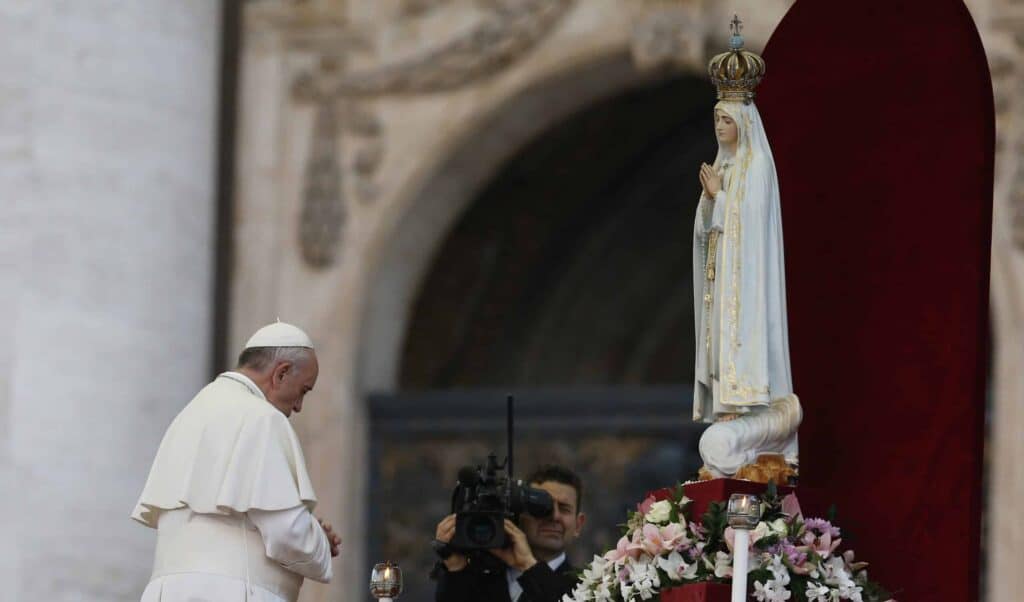In 1896, in spiritual notes jotted down by the future Pope St. John XXIII, we read of his resolution to “watch myself more carefully” so as to succumb less to distractions in particular moments of prayer. Among these, he includes the “five Our Fathers after dinner.”
He’s not the only pope to refer to this devotion as a part of his spiritual life.
During a general audience in 2016, Pope Francis spoke about his nighttime prayer routine.
“In the evening, before going to bed, I say this short prayer: ‘Lord, if you will, you can make me clean!’ And I pray five ‘Our Fathers,’ one for each of Jesus’ wounds, because Jesus has cleansed us with his wounds.”
He encouraged the faithful to take up this simple devotion and “think about Jesus’ wounds and say an ‘Our Father’ for each of them. Jesus always hears us.” (Of course Jesus had hundreds more than five wounds, but this devotion focuses on the wounds caused by the nails in each hand and foot and on the piercing of his side.)
In fact, Pope Francis spoke of his devotion to Christ’s wounds dozens of times during his Petrine ministry, both in official documents and in more casual references in homilies or addresses.
What is it about the wounds of Christ that attracted Pope Francis?
An Easter devotion
One might think that devotion to the five wounds of Christ would fall squarely on Good Friday, perhaps after 3pm, shortly before the fifth wound — the piercing with the lance — was inflicted. Certainly, that would be a beautiful time to meditate on this mystery.
But in fact, Pope Francis’ devotion to the wounds could more aptly be described as an Easter devotion, and one particularly suited to Divine Mercy Sunday.
For Francis, the wounds were a sign of God’s infinite mercy. We can “learn how to rest in his wounds, and there to be cleansed of all our sins and foolish ways,” he said.
On Divine Mercy Sunday in 2018, he reflected: “We discover that the very sin that kept us apart from the Lord becomes the place where we encounter him. There the God who is wounded by love comes to meet our wounds. He makes our wretched wounds like his own glorious wounds. There is a transformation: My wretched wounds resemble his glorious wounds. Because he is mercy and works wonders in our wretchedness.”
In 2024, he noted how the disciples responded when Christ asked them to look at his wounds: “They are signs of suffering and pain. They could have stirred feelings of guilt, yet with Jesus they become channels of mercy and forgiveness. In this way, the disciples see and touch with their hands the fact that with Jesus, life always wins, and death and sin are defeated.”
“In those wounds, (Thomas) touches with his hands God’s tender closeness,” Pope Francis affirmed. The “resurrection” of Thomas was “accomplished when his frail and wounded humanity enters into that of Jesus. There, every doubt is resolved; there, God becomes my God; there, we begin to accept ourselves and to love life as it is.”
“To enter into Jesus’ wounds is to contemplate the boundless love flowing from his heart,” he said in 2018. “This is the way. It is to realize that his heart beats for me, for you, for each one of us.”
“You will never know Jesus Christ if you don’t touch his injuries, his wounds,” Pope Francis insisted.
Our wounds, his wounds, others’ wounds
The experience of the tenderness of God with our sins and woundedness naturally leads to caring for others’ wounds, Pope Francis often observed.
During a visit to the suffering nation of Myanmar in 2017, he said: “By taking refuge in Christ’s wounds, dear brothers and sisters, may you know the healing balm of the Father’s mercy and find the strength to bring it to others, to anoint every hurt and every painful memory.”

And that same year in Fatima: “On the altar, we worship the flesh of Jesus; in these our brothers and sisters, we encounter the wounds of Jesus.”
Going deeper
There’s another, deeper element to find in the Pope’s devotion.
In 2020, in a homily shared from Santa Marta, the Pope considered something that, he said, should fill us with confidence.
“We are used to praying to Jesus … but we are not accustomed to contemplating Jesus who shows the Father His wounds, Jesus the intercessor, the mediator, Jesus who prays for us.”
Jesus now is in prayer, the shepherd-priest beseeching God for his lambs, and this is Jesus with his wounds.
Earlier, in 2014, Pope Francis had spoken of his certainty that Jesus probably does not use many words with the Father. “There is one thing that Jesus does today, I am certain that he does this: He shows his wounds to the Father. And Jesus, with his wounds, prays for us as if to say ‘Father, this is the price! Help them, protect them, they are your children whom I have saved.'”
He added, reflecting that after his resurrection, Jesus had “this glorious, beautiful body: There were no bruises, there were no cuts from the scourging — all were healed, but the five wounds were there. … Jesus wanted to take them to heaven to pray for us, to show the Father the price.”
An ancient devotion
Pope Francis drew this devotion not just from recent practice. It goes much farther back even than Pope St. John XXIII.
In particular, Francis spoke at least twice of a homily of St. Bernard (d. 1153).
In the homily, St. Bernard says that “through those holes I can taste wild honey and oil from the rocks of flint, that is, I can taste and see that the Lord is good. … No longer is he unable to take pity on my weakness. The wounds inflicted on his body have disclosed to us the secrets of his heart; they enable us to contemplate the great mystery of his compassion.”
For Pope Francis, the saint’s words brought back charity: “The wounds of humanity, if you approach them, if you touch them — and this is Catholic teaching — you touch the wounded Lord.”
And as Pope Francis canonized his predecessor, Pope John XXIII, he spoke of this devotion:
“Those wounds are the enduring sign of God’s love for us. They are essential for believing in God. Not for believing that God exists, but for believing that God is love, mercy and faithfulness.”
A devotion for us
“Look at the crucifix, but to look within it,” Pope Francis exhorted in 2018. “There is this beautiful devotion to pray an Our Father for each one of the five wounds: When we pray that Our Father, we seek to enter through Jesus’ wounds inside, inside, right to His heart. And there we will learn the great wisdom of Christ’s mystery, the great wisdom of the cross.”
“If, gazing on the face of Christ, you feel unable to let yourself be healed and transformed, then enter into the Lord’s heart, into his wounds, for that is the abode of divine mercy.”
“Jesus’ wounds are here and in Heaven before the Father. We heal the wounds of Jesus here and he, from Heaven, shows us his wounds and says to us all, to all of us: ‘I am waiting for you!’ Let it be so!”








